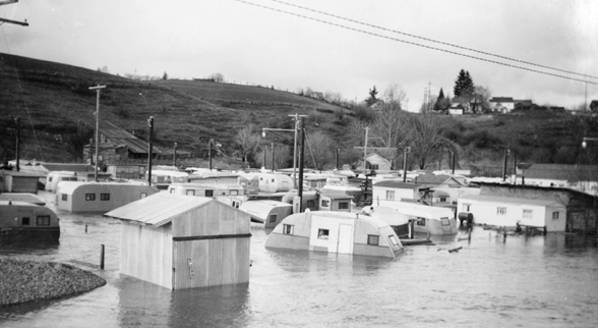Personal tools
Help
Tools
Class Notes
- Do you have news for fellow WSU alumni and other readers of Washington State Magazine? Send us your class note.
Our Story
written by alumni, faculty and friends.
NOTE: THIS IS A LEGACY SITE AND IS NOT REGULARLY MAINTAINED
Views
User:MarkOEnglish
From Our Story
Mark O'English is WSU's University Archivist.
At the moment, I'm going to play with creating content on this page with the idea that it will eventually be moved to a live page.
Noting so far... image controls not working - no captions; no ability to change size (well, its there in rich editor, but doesn't seem to work). For that matter, as of 1-29 I can no longer upload images (Internal error. Could not find file "C:\WINDOWS\Temp\phpAD.tmp".).
Floods of 1948
--- insert image PC 70, 10025c here ---
In 1948, a trailer camp of 115 trailers existed down on the banks of Paradise Creek, housing 304 married students (many World War II veterans), spouses, and children. On January 7th that year, the Creek's waters rose up and threatened the camp, but 500 students and townspeople gathered to build a dike consisting of 20,000 sandbags (actually bags of split peas from the Klemgard Pea Processing Plant as well as sand from the nearby Doten Trans-Mix Plant). Upstream from the camp, the sandbags formed a large "dam" forcing the waters to spread out over what would later become the Bishop Boulevard area, and the a wall of sandbags extended all the way down the riverbank into Pullman. While the river rose to a full three feet higher than the trailer court's ground level (reportedly the deepest flood the river had ever experienced), the dikes held and eventually the waters retreated, and the residents were returned to their trailers and a regimen of cleaning, boiling of water, and disinfection and discarding of foods.
Unfortunately, that day's record as "worst ever flood" was short lived, and a month and a half later, on February 21st, the Creek's waters rose up and threatened the camp again, this time a full feet deeper than January's flood. Extensive work by the university students and the Pullman townspeople resulted in an even larger dike, and once again the trailer court's residents escaped the worst of the flooding.
Four days later, on February 25th, 1948, the river rose again in a flood deeper than either of the two of the previous months, and again the students and townspeople met it with sandbags. About 5:00 AM on the morning of the 26th, however, the dikes broke at the upper dam in two places, and the trapped waters rushed downstream, instantly inundating the camp and trapping its occupants, may of whom were home and sleeping. The following day's Evergreen recounts that "a human chain was formed across a narrow crossing (waist deep) and the victims passed along and out to safety." Many of the residents were incapable of fighting the current, and had to be carried out on the shoulders of volunteers. On her notations on photos donated to the University Archives, Marjorie (Schmid) Kee recalls having been asleep in her and her husband's trailer when the dikes broke, and having to swim to the railroad embankment where volunteers were able to pull her from the waters. In the Evergreen, student Joe Sobello reports that he'd just evacuated himself, his wife, and their two year old son when the dike broke, and he witnessed his home wash away, hit another trailer, and break into pieces. Loyd Bury, owner of the trailer camp area, reflected "it is a miracle no lives were lost. If it had not been that we had a group of war trained veterans, there must surely have been a loss of life."
As he had in the previous floods, college President Wilson Compton had opened the Stadium Commons cafeteria as a refuge for the trailer residents; in the aftermath of this latter flood the President's House was used as a clearinghouse for housing refugees. Again the town and school came to the support of those in need, and the following week Dr. Compton, in an expression of gratitude, noted that all the dislocated families had been found places to stay within the community within twelve hours; three times the total number of needed homes had been offered by the townspeople. The University made a variety of allowances to ensure the refugees' schooling was no impacted, and the Red Cross provided those needing them with new textbooks and clothing.
WSU's Manuscripts, Archives, and Special Collections' digital collections contain many more photographs from the 1948 floods.
Our Story site map
Our Story main page | Our Story categories | Help Desk
Contact | Give | Advertise
Washington State Magazine | Washington State University | Class Notes
Our Story is coordinated by
In partnership with
Our Story and Washington State Magazine are publications of Washington State University. All rights reserved.
P.O. Box 641227, Washington State University, Pullman, WA 99164-1227 USA | wsm@wsu.edu, 509-335-2388
Accessibility | Copyright | Policies

